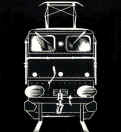
The Electric Trans-Pennine Way
The Woodhead Railway

|
|
The Electric Trans-Pennine Way The Woodhead Railway |
|
Scenes on the Manchester, Sheffield and Wath electric railway since 1968.
Click on photos for a larger image Use browser "BACK" button to return.
| This is Manchester Piccadilly Station, Platform 1 in August 1968. An EM1 Class 76 hauled express is ready to depart for Sheffield Victoria. The train consists of five ex LMS corridor compartment coaches. The Class 76 which brought in the train from Sheffield Victoria is at the buffers. | |
| Not many stations could claim the distinction of having overhead AC and DC on adjacent platforms. Platforms 1 to 4 were energised at 1.5Kv DC and Platforms 5 upwards were energised at 25Kv 50Hz AC. The EM1 Class 76 is off to Sheffield Victoria and the AL6 Class 86 and the BR Mk. 1 coaches are off to the south. August 1968. | |
| This is Sheffield Victoria in August 1968 and the EM1 Class 76 has run around the five coaches and will attach to the other end, ready for the return to Manchester Piccadilly. This Locomotive is E26053 and carries the nameplate Perseus. This passenger service between Manchester Piccadilly and Sheffield Victoria ceased in January 1970. | |
| Still at Sheffield Victoria in August 1968 and an unusual visitor arrives. Diesels operating under Pennine wires were not that common unlike today where the majority of trains on the East Coast and West Coast main lines are unable to utilise the live wires above. | |
| On now to July 1977 and we are at Woodhead Station on a typical summer Pennine day, wet and misty. The leading locomotive is 76022 and was the only Class 76 to retain the British Railways lion and wheel logo until the end of its days. | |
| The electrification continued beyond Sheffield Victoria Station to exchange sidings at Rotherwood. Here motive power was exchanged between the Woodhead Class 76 electrics and usually pairs of Class 37 diesel electrics. July 1977. | |
| On a more summer like day in July 1977, we once again see 76022 with a friend just having emerged eastbound from under the hill (Woodhead Tunnel), approaching Dunford Bridge station. | |
| Back at the western portal of Woodhead Tunnel and an unusual scene on the Pennine Line, seeing two trains in action at the same time. July 1977. | |
| No, they have not forgotten to detach the Worsborough banking locos. This scene shows an eastbound train on the westbound track, The eastbound line was out of action and single line working was in force on the remaining track. July 1977. | |
| The view from above the western portal of Woodhead Tunnel adjacent to the main A628 road. This time the eastbound train is on the correct track. July 1977. | |
| Viewed from the westbound platform at Dinting, a loaded coal train heads west. July 1977. | |
| From Dinting Station footbridge a pair of Class 76 locos head east with a train of empty HAA hopper wagons to collect more coal from Yorkshire. July 1977. | |
| Dinting Station in July 1977 and a Manchester bound Class 506 takes the direct route from Hadfield without calling at Glossop. | |
| After the 5th of January 1970 the only passenger service remaining on the Woodhead line was the commuter service between Manchester Piccadilly to Glossop and Hadfield. Here we see a Class 506 unit emerge from the Glossop line at Dinting and head towards Hadfield. July 1977. | |
| This Class 506 at Dinting is on route for Hadfield but first it will call at Glossop where a reversal of direction will take place. July 1977. | |
| Viewed from the Huddersfield platform at Penistone, a pair of Class 76's are seen passing Huddersfield Junction signal box taking a loaded coal train west. July 1977. | |
| After the ending of the through passenger service to Sheffield in 1970, local passenger service remained at the western end between Manchester Piccadilly, Glossop and Hadfield operated by Class 506 units. This is Hadfield in July 1977. East of here, only freight trains operated. | |
| Almost everyone that visited Dinting in the 1970's came to see steam locomotives. Commented on at the time was that the Pennine Electrics would be gone well before the steam locomotives in the Dinting Steam Center. History subsequently proved this ominous forecast accurate. Here we see a Class 506 on route to Glossop passing the access line to the steam centre. April 1978. | |
| It's back to the 1970's. We are at Reddish Depot in Greater Manchester. This was the main depot for the Class76 locomotives and also the Class 506 electric units. This is April 1978. | |
| Here we see the lion and wheel locomotive 76022 in for a bit of maintenance in the depot at Reddish. July 1978. | |
| Guide Bridge was usually a good place to see a miscellany of motive power, especially at weekends. May 1978. | |
| A line up of Class 76, a Class 506 and a Class 40 have the weekend off. May 1978. | |
| This is Glossop and was at the end of a branch line from Dinting. May 1978. | |
| As freight trains did not normally operate at weekends, there were usually plenty of Class 76's to be seen resting at various locations such as Rotherwood and Guide Bridge. This scene is at Wath, one of the eastern extremities of the electrified line. May 1978. | |
| Just west of Dinting Viaduct is Mottram, where a number of sidings were located. Here a local passenger train approaches Mottram Staff Halt. July 1980. | |
| Having just passed Mottram Staff Halt, the unit continues to Manchester. July 1980. | |
| Manchester Piccadilly Station in July 1980. The Class 76 hauled express passenger trains to Sheffield Victoria via Woodhead is now a distant memory but the Class 506 units maintain a local service to Glossop and Hadfield. | |
| Electrification was later extended into Tinsley Yard near Sheffield. No electric locomotives were present on this day but one of the three Class 13 diesel electric locomotives is working the yard. July 1977. | |
| This westbound train is passing the signal box at Hadfield Station. The westbound platform had been removed years before and passenger trains arrived and departed from the eastbound platform. July 1980. | |
| West of Mottram is Godley Junction. This was a motive power interchange point between the Woodhead electrics and diesel electric power. July 1980. | |
| This Glossop and Hadfield bound train is at Godley Junction Station. Although passenger trains still operate on this part of the line, this Godley Station is closed and a new station opened further to the west. July 1980. | |
| Looking east from the platform at Godley Junction a pair of Class 76 locos await to collect an eastbound train. July 1980. | |
| The view looking east from Godley Junction platform and the signal box controlling the junction. July 1980. | |
| The Worsborough incline was the only place in the UK where you could see four locomotives on one train. There are two Class 76's on the front and another two on the back to give banking assistance on this heavy coal train which has just departed westbound from Wombwell Main Junction. July 1980. | |
| Reddish depot was the main maintenance facility for the Pennine Electrics. However some locos seemed surplus to requirements. July 1980. | |
| This Class 40 is hardly being taxed with this freight train. In the background the collection of dead Class 76 locos is beginning to mount up. July 1980. | |
| The line from Wath joins the Sheffield to Manchester main line at Barnsley Junction Here we see a loaded coal train which has recently detached the two banking locos crossing Oxspring Viaduct near Penistone. | |
| We are at Deepcar and fortunate to see a westbound train of BOC (British Oxygen Company) bogie tankers. July 1980. | |
| Also at Deepcar this Class 101 unit heads east for Sheffield. Perhaps the driver is a bit confused as the destination board states Southport. July 1980. | |
| At this location there used to be Crowden Station. Quite why a station was required here is strange as there was no adjacent habitation. July 1980. | |
| An eastbound train passes the site of Crowden Station. July 1980. | |
|
The final Class 76 train working took place on the 17th of July 1981. |
|
| The Woodhead Railway-Epilogue | |
| On now to April 1982 and at Rotherwood there is not much activity. All the overhead wires have now been removed. | |
| This is Wath and it is now an electric free zone. Once again the valuable overhead wires have been removed. April 1982. | |
| After leaving Wath we are now at Darfield Main signal box. The wiring on the Wath line was soon removed after the cesation of electric operations. April 1982. | |
| The track and overhead was soon removed from the Worsborough line. All that remained was ballast and the stump of a gantry that had been burned through. April 1982. | |
| The eastern end of Woodhead Tunnel is at Dunford Bridge. Here the overhead was still intact and live, no doubt to deter nefarious villains from making off with their ill gotten gains. April 1982. | |
| Even after almost two years since the end of operations all seems intact. April 1982. | |
| The western end of Woodhead Tunnel and all seems intact and also live. April 1982. | |
| West from Woodhead is Torside signal box and level crossing on the B6105 road. If it were not for the rust on the rails the optimist could expect another train soon. April 1982. | |
| On to May 1986, all operation ends here at Hadfield and the remaining passenger lines have been converted from 1500v DC to 25Kv 50Hz AC. For a short period, services to Glossop and Hadfield were provided by some imported Class 303 Scottish "Blue Trains". | |
| Looking east from the eastern end of the Woodhead Tunnel and one of the tracks, the overhead and fortunately for us, the fence have now all gone. August 1986. | |
| Looking west from the western portal of Woodhead Tunnel the implements of destruction are in sight. Again there was no restriction of access to the tunnel. August 1986. | |
| Back at Hadfield but forward another two years to July 1988. The Scottish "Blue Trains" have gone and have been replaced with Class 304 units. | |
| Heading for Glossop this Class 323 unit is passing what was once the entrance to Dinting steam depot. September 2004. | |
| Yet again at Hadfield but now it's September 2004. The Class 304 units have been replaced with Class 323 units. Note how the undergrowth has engulfed the station area making the previous two views impossible. | |
| This Glossop and Hadfield bound train has just passed the sight of Mottram Staff Halt. Note how the westbound yard that was on the right has completely disappeared in jungle. Compare with the 1980 view previously. September 2004. | |
|
Another location where the jungle has taken over is
Rotherwood. The former stabling point for the Class 76 locomotives and the
sidings where diesel and electric power was interchanged on the coal trains
has reverted back to nature. April 2018. Photo: John Webster. |
|